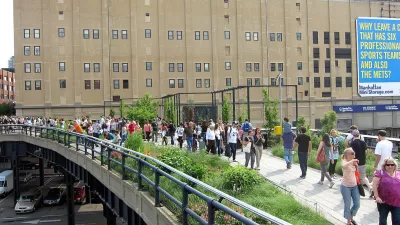By transforming excess street space in areas like Times Square and Herald Square into pedestrian paradises, New York City's plaza program has been a huge hit. But with maintenance costs borne by local businesses, less affluent areas have missed out.
Late last month Transportation Commissioner Janette Sadik-Khan "announced an $800,000 grant from J.P. Morgan Chase & Co., which will seed a new Neighborhood Plaza Program intended to help communities that want pedestrian plazas to cope with the cost of maintaining them," reports Ted Mann.
"The new program will help surmount one economic hurdle: for some communities that would happily host a plaza, assembling the annual budget for maintenance, through contributions from private shop-owners or local foundations, is tough to do."
“'At the beginning, to say to somebody, ‘You have to raise $60,000 to maintain this plaza,’ that’s quite a challenge,' said Sara Hobel, executive director of the Horticultural Society. Her group will work with the Association for Community Employment Programs for the Homeless, which plans to train maintenance workers to perform upkeep on the plazas, much as the society already does with workers on Rikers Island."
FULL STORY: Neighborhood Pedestrian Plazas to Become More Affordable

Maui's Vacation Rental Debate Turns Ugly
Verbal attacks, misinformation campaigns and fistfights plague a high-stakes debate to convert thousands of vacation rentals into long-term housing.

Planetizen Federal Action Tracker
A weekly monitor of how Trump’s orders and actions are impacting planners and planning in America.

In Urban Planning, AI Prompting Could be the New Design Thinking
Creativity has long been key to great urban design. What if we see AI as our new creative partner?

King County Supportive Housing Program Offers Hope for Unhoused Residents
The county is taking a ‘Housing First’ approach that prioritizes getting people into housing, then offering wraparound supportive services.

Researchers Use AI to Get Clearer Picture of US Housing
Analysts are using artificial intelligence to supercharge their research by allowing them to comb through data faster. Though these AI tools can be error prone, they save time and housing researchers are optimistic about the future.

Making Shared Micromobility More Inclusive
Cities and shared mobility system operators can do more to include people with disabilities in planning and operations, per a new report.
Urban Design for Planners 1: Software Tools
This six-course series explores essential urban design concepts using open source software and equips planners with the tools they need to participate fully in the urban design process.
Planning for Universal Design
Learn the tools for implementing Universal Design in planning regulations.
planning NEXT
Appalachian Highlands Housing Partners
Mpact (founded as Rail~Volution)
City of Camden Redevelopment Agency
City of Astoria
City of Portland
City of Laramie



























